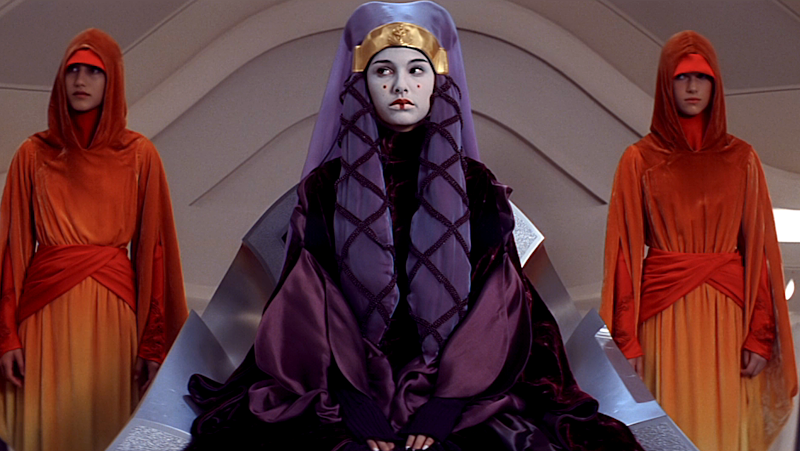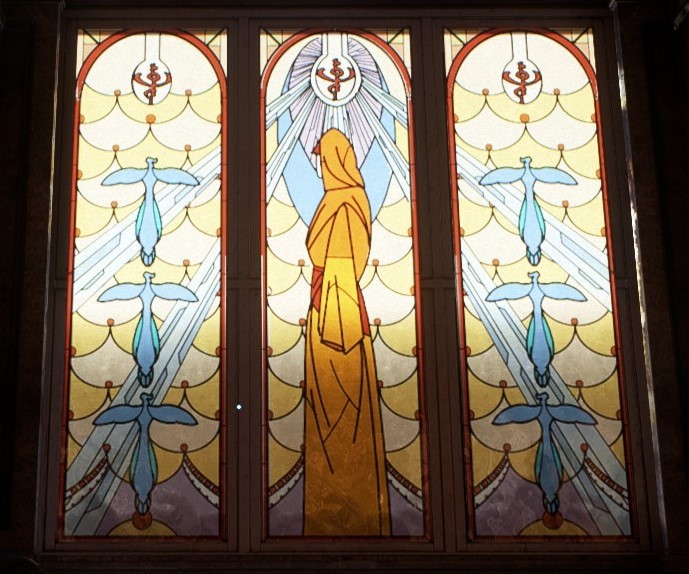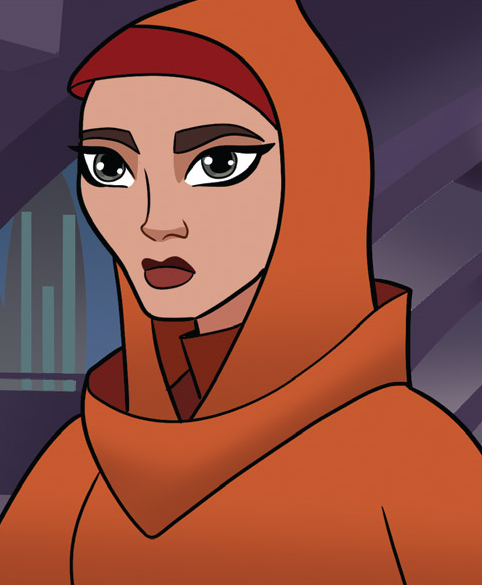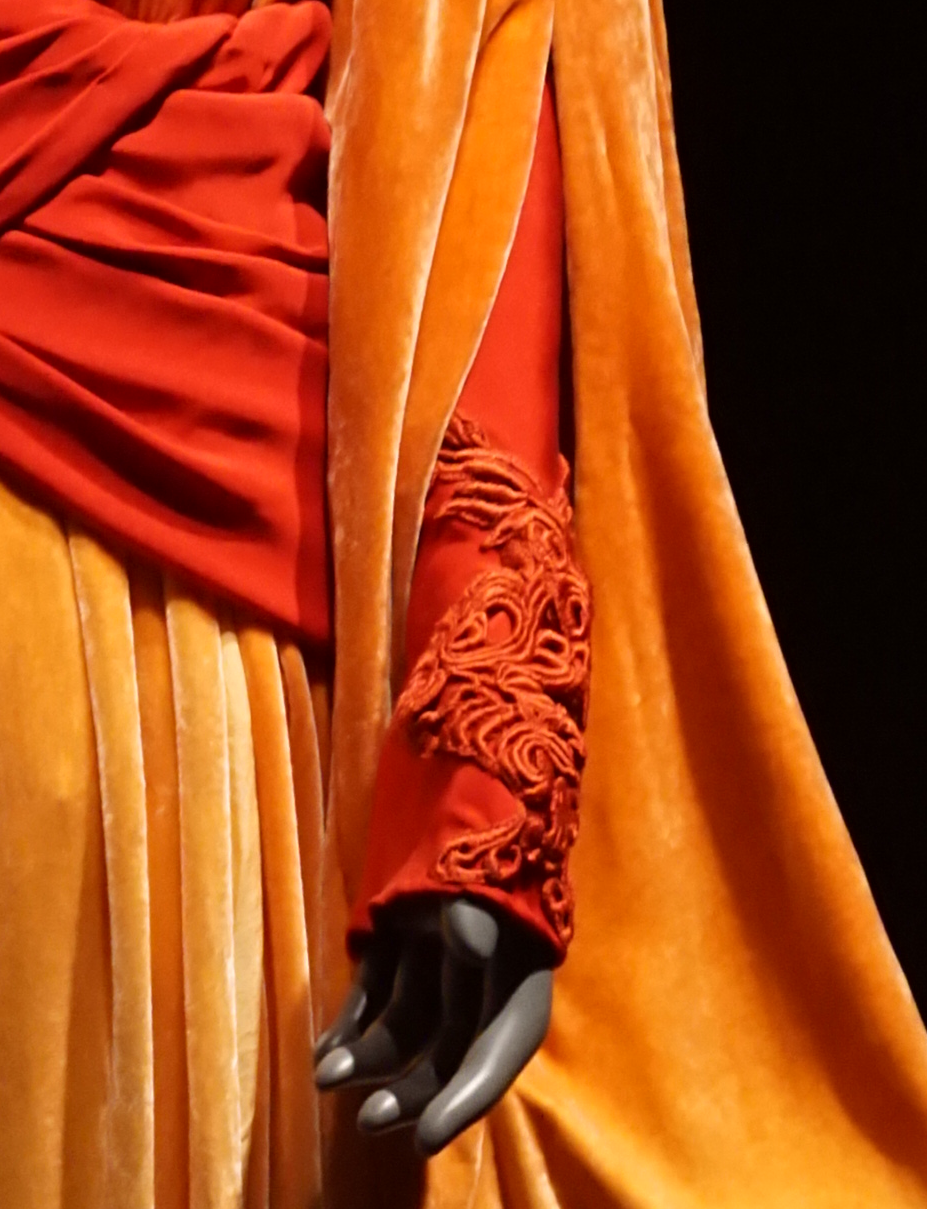Flame-colored robes were worn by the handmaidens of Padmé Amidala when she served as queen of the planet Naboo. The robes were designed by the handmaiden Yané to complement several of the queen's outfits and help the handmaidens fade to the background. They were worn by the handmaidens throughout Amidala's term as Queen of Naboo, including during the Invasion of Naboo, when Amidala escaped the planet hidden among her handmaidens.
The robes enjoyed an enduring life as a wearable garment: robes in the same style were also worn by Amidala's handmaidens during her tenure as a senator in the Galactic Republic Senate and by the handmaidens of a later queen of Naboo, Sosha Soruna. Flame-colored robes were immortalized in artworks depicting Amidala after her term as queen ended, and their image reached beyond Naboo in pin-up posters displayed in cantinas, barracks, and other public locations from the Core Worlds to the Outer Rim Territories.
The flame-colored robes featured a yellow-to-orange ombré outer robe over an orange under-robe made of Karlini silk. The lighter under-robe was made to help prevent sweat stains as the outer robe was difficult to clean. The ensemble included a two-piece hood that covered the wearer's hair and neck and shadowed their face. To complete the outfit, a sash matching the orange under-robe was wrapped wide around the back, crossed, and tucked at the front of the waist to form petal-like shapes over the hips. The sunrise-like appearance of the robes symbolized the rebirth of the Mid Rim Territories planet Naboo.

Sabé and Rabé wear flame-colored robes while attending the queen of Naboo.
The handmaiden Yané designed the flame-colored robes for Padmé Amidala's handmaidens during her first term as queen of the planet Naboo in 32 BBY. The handmaidens often wore hoods, which quickly touched off a trend for wearing similarly styled hooded garments among the Naboo people that rendered the flame-colored robes unremarkable in silhouette. Flame, however, quickly became the handmaidens' signature color, and they found that the saturated hues drew attention away from the individual wearer.
The handmaidens typically wore matching robes, chosen to complement whichever outfit was selected for the queen from her extensive wardrobe. During Amidala's first term, the flame-colored robes were paired with at least two different gowns: they provided a stark contrast with a black traveling gown and matching feathered headdress, and they complemented the rich hues of a somber dark purple traveling dress.

Padmé Amidala wears the flame-colored robe of a handmaiden while Sabé plays the queen.
As part of its invasion of Naboo in 32 BBY, the Trade Federation occupied the city of Theed in an attempt to force the queen into signing a treaty. As soon as Amidala's Head of Security, Quarsh Panaka, noticed something amiss, the handmaiden Saché used the pre-arranged code word "flame" to signal all the handmaidens to gather in the throne room of the Theed Royal Palace dressed in the flame-colored robes.
Later, hidden among her handmaidens, Amidala escaped the planet and the Federation, wearing the robes as a disguise. She continued to wear them and go by the name "Padmé" while on the royal starship alongside her handmaidens Rabé and Eirtaé while Sabé posed as the queen. The robes also proved useful while Yané and Saché were trapped in the Trade Federation's prison camp; Yané shredded their under-robes and used them to weave coded messages. Using the pattern of a comm code commonly learned by Naboo children, the colorful silk threads outlined guard rotations and key strategic locations for the resistance against the Trade Federation.

A stained glass window in the Theed Royal Palace depicted a flame-colored robe.
The flame-colored robes saw continued use after the Invasion. When the Gungan Jar Jar Binks brought news to Queen Amidala of a map to a powerful Gungan relic, her handmaidens were again wearing the flame-colored robes.
A stained glass window in the Theed Royal Palace commissioned during the reign of Réillata, Amidala's successor, depicted Amidala taking part in a royal procession, surrounded by many handmaidens wearing flame-colored, hooded outfits. By the time of the Clone Wars fought between the Galactic Republic and the Confederacy of Independent Systems, the palace also had a stained glass window picturing a lone figure in profile wearing the flame-colored robe and a painting of a group of eight figures dressed in flame-colored robes crossing a courtyard.
A pin-up poster featuring a woman wearing the robes was also widely available in the galaxy during the Clone Wars. Copies of the poster hung in places as far flung as a cantina on the lower levels of the city-world Coruscant in the Galactic Core and locations in the Outer Rim such as a Weequay pirate lair on the planet Florrum, Republic clone trooper barracks on the world of Christophsis, and the outside of a building on the planet Iego.

Cato Parasitti impersonates the handmaiden Karté.
During Amidala's time as a senator of the Republic's Senate, shortly after the outbreak of the Clone Wars, Sabé wore the outfit once again when she greeted Amidala following her return from the planet Hebekrr Minor and helped her prepare for bed. Sabé also told Amidala that she had learned of her secret marriage to the Jedi Knight Anakin Skywalker and mentioned that she had decided to leave her position as Amidala's handmaiden, not able to keep up with all the changes in Amidala's life and wishing to be her own person rather than simply Amidala's shadow.
The disguise was used against Amidala when the Clawdite bounty hunter Cato Parasitti shape-shifted into the form of Amidala's handmaiden Karté and attempted to disrupt a delicate negotiation with the Arthurian delegates. When Amidala and her friend Ahsoka Tano discovered the deception and fought off the bounty hunter, Parasitti was dressed in a flame-colored robe to complete her handmaiden disguise. Handmaidens wearing flame-colored robes also attended Amidala as she met up with Skywalker for a mission.
The retinue of at least one other queen of Naboo also wore similar robes. In 4 ABY, an agent of the remnant Galactic Empire executed Operation: Cinder on Naboo, activating a climate disruption array which caused hurricanes and dangerous electrical storms across the planet. As Queen Sosha Soruna prepared to launch an attack on the array, she was aided by two handmaidens who wore robes identical to the flame-colored robes worn by Amidala's handmaidens.
Flame-colored robes were created for the prequel trilogy film Star Wars: Episode I The Phantom Menace, released May 19, 1999. In the Star Wars Legends continuity, they appeared prior to the film in its novelization, which was written by Terry Brooks and published on April 21, 1999.
The robes were not named in the film. However, in the Legends junior novelization, written by Patricia C. Wrede and released May 3 of the same year, they were identified as "flame-colored robes." That name was first used in the current Star Wars canon in the 2017 reference book Star Wars: The Visual Encyclopedia. From 2015 to 2018, the Smithsonian Institution Traveling Exhibition Service exhibited the costume as "Handmaiden, Ombréd Travel Gown" in Rebel, Jedi, Princess, Queen: Star Wars and the Power of Costume.

Detail of the sleeve shows red under-sleeve with guipure lace trim
When designing for the handmaidens, concept artist Iain McCaig drew simpler hairstyles and tried to evoke a more Pre-Raphaelite or art nouveau flavor than the queen's more elaborate costumes. His Naboo costume designs deliberately obscured details like size, shape, and age because they would be used for disguise. Working with McCaig, costume designer Trisha Biggar turned the sketches into outfits that would work on screen. Biggar envisioned a dress code and a specific style for ceremonial regalia for queens and handmaidens, which included common silhouettes and motifs. In addition, Biggar sought to keep the handmaidens in petite, vertical costumes to contrast with Amidala's larger, diagonal ensembles. The handmaidens' outfits were dyed to complement the queen's ensembles.
The hooded dresses were originally made in white silk and viscose velvet and then disassembled and ombré-dyed so that the depths and levels of the colors matched when the handmaidens stood side by side. The red sashes, sleeves, and inner hoods were sewn from bias-cut silk crepe. Antique guipure lace motifs were dyed to match and used to trim the sleeves.